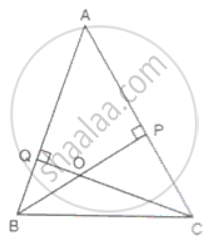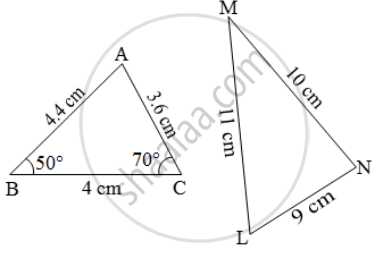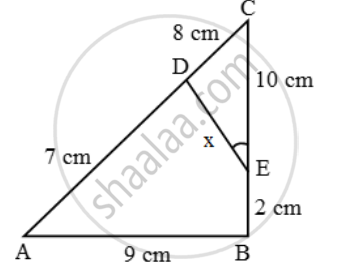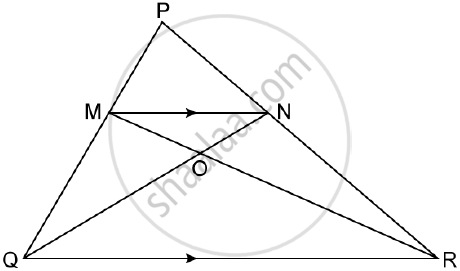Advertisements
Advertisements
प्रश्न
In ΔABC, BP and CQ are altitudes from B and C on AC and AB respectively. BP and CQ intersect at O. Prove that
(i) PC x OQ = QB x OP
(ii) `"OC"^2/"OB"^2 = ("PC" xx "PO")/("QB" xx "QO")`
उत्तर
(i) In ΔOBQ and ΔOPC
∠OQB = ∠OPC = 90° ...(QC and BP are altitudes)
∠QOB = ∠POC ...(vertically opposite angles)
Therefore, ΔOBQ ∼ ΔOPC
⇒ `"PC"/"OP" = "QB"/"OQ"`
⇒ PC x OQ = QB x OP
(ii) Since ΔOBQ ∼ ΔOPC
`"OC"/"PO" xx "OC"/"PC" = "OB"/"QB" xx "OB"/"QO"`
⇒ `"OC"^2/("PC" xx "PO") = "B"^2/("QB" xx QO")`
⇒ `"OC"^2/"OB"^2 = ("PC" xx "PQ")/("QB" xx "QO")`.
APPEARS IN
संबंधित प्रश्न
In figure, find ∠L

In figure, ∠A = ∠CED, prove that ∆CAB ~ ∆CED. Also, find the value of x.

Using Basic proportionality theorem, prove that a line drawn through the mid-points of one side of a triangle parallel to another side bisects the third side. (Recall that you have proved it in Class IX).
In ΔPQR, MN is parallel to QR and `(PM)/(MQ) = 2/3`
1) Find `(MN)/(QR)`
2) Prove that ΔOMN and ΔORQ are similar.
3) Find, Area of ΔOMN : Area of ΔORQ

State, true or false:
All equiangular triangles are similar.
State the SAS-similarity criterion
A triangle ABC is enlarged, about the point O as centre of enlargement, and the scale factor is 3. Find : A' B', if AB = 4 cm.
The sides PQ and PR of the ΔPQR are produced to S and T respectively. ST is drawn parallel to QR and PQ: PS = 3:4. If PT = 9.6 cm, find PR. If 'p' be the length of the perpendicular from P to QR, find the length of the perpendicular from P to ST in terms of 'p'.
Find the scale factor in each of the following and state the type of size transformation:
Model area = 75cm2, Actual area = 3cm2
Prove that if a line is drawn parallel to one side of a triangle intersecting the other two sides in distinct points, then the other two sides are divided in the same ratio.
Using the above theorem prove that a line through the point of intersection of the diagonals and parallel to the base of the trapezium divides the non-parallel sides in the same ratio.
